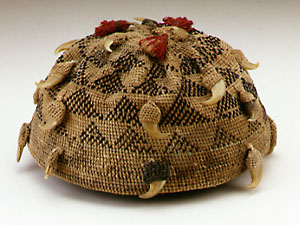
Kongo peoples, Republic of the Congo,
Democratic Republic of the Congo
Plant fiber, cotton, leopard claws, dyes
c. 1890
95-2-1, museum purchase
In 1482 Portuguese navigator Diogo Cao reached the Congo River estuary and encountered the Kongo kingdom, which was ruled by a king with a network of provincial governors, advisers and village chiefs. Cao noted that persons of authority wore a variety of headdresses to signify their power and status. Because the Kongo peoples associate the strength, cunning and ferocity of important chiefs with that of the leopard, caps decorated with leopard claws are among the most prestigious. Similar caps are also represented on Kongo figurative sculpture.
Kongo artists fashioned caps from palm, pineapple or banana leaves as well as cotton. The interior fibers of the leaves were stripped, dried and shredded into thin threads. Starting from the center of the crown the caps were constructed in a spiral, the threads wrapped or looped around themselves several times into tightly woven patterns. Geometric designs were made using the overhand knot technique, which gives the cap a raised knotted surface. Leopard claws and other materials were added later.